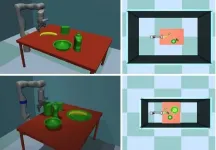(Press-News.org) UNIVERSITY PARK, Pa. -- One of the most important and widespread reef-building corals, known as cauliflower coral, exhibits strong partnerships with certain species of symbiotic algae, and these relationships have persisted through periods of intense climate fluctuations over the last 1.5 million years, according to a new study led by researchers at Penn State. The findings suggest that these corals and their symbiotic algae may have the capacity to adjust to modern-day increases in ocean warming, at least over the coming decades.
Cauliflower corals -- which are in the genus Pocillopora -- are branching corals that provide critical habitat for one-quarter of the world's fish and many kinds of invertebrates, such as lobsters, sea urchins and giant clams. They are common throughout the Indo-Pacific -- the region extending from eastern Africa, north to India and Southeast Asia, across Australia and encompassing Hawaii -- and are capable of long-range dispersal and rapid growth, making them among the first species to repopulate reefs damaged by typhoons and events of mass coral bleaching and mortality.
"We found that Pocillopora has maintained a close relationship with certain species of algae in the genus Cladocopium over repeated oscillations in Earth's climate," said Todd LaJeunesse, professor of biology, Penn State. "Our findings reinforce how stable and resilient these relationships are over deep time."
LaJeunesse explained that corals comprise hundreds to hundreds of thousands of individual animals, called polyps. Tiny, single-celled algae, known as dinoflagellates, live inside these polyps' tissues, giving the corals their color and providing the animals with up to 90% of their energy needs through the products of photosynthesis. These dinoflagellates significantly influence the capacity of corals to deal with environmental stressors.
For two decades, LaJeunesse and his colleagues have been collecting coral samples from around the world, using molecular-genetic techniques to identify the coral and algal species, documenting the specificity of the partnerships (some species of algae are highly specific to certain species of coral, whereas others are generalists and can associate with many different types of coral) and determining how these partnerships have changed through evolutionary history.
"Important biological discoveries are more likely when working with accurate species resolution -- in this case, for both coral and dinoflagellate," said LaJeunesse. "Research on the biology of photosynthetic corals has been hampered by a lack of good taxonomic resolution. Our work on resolving these species is highly detailed and currently among the most sophisticated."
The team used a combination of genetic, ecological and morphological -- the outward appearance of an organism -- techniques to examine Cladocopium that associate with Pocillopora. Specifically, they relied on a variety of genetic markers -- or DNA sequences with known locations on chromosomes -- to determine the genetic identities of the species. They also used a microscope to visualize and image the Cladocopium cells. The findings published on May 20 in the ISME Journal, the official journal of the International Society for Microbial Ecology.
"With this research, we now know that Cladocopium, the most common genus of coral symbionts, comprises hundreds of species," said Kira Turnham, graduate student in biology, Penn State. "We were able to identify and describe two species, which we named Cladocopium latusorum and Cladocopium pacificum, and with this resolution, were able to deduce the age of their partnerships and unique importance to specific host corals."
Next, the team investigated whether Cladocopium from geographically dispersed populations of Pocillopora were reproductively isolated or displayed connectivity. They found that populations of both species, like their Pocillopora hosts, are genetically well-connected across the tropical and sub-tropical Pacific Ocean, indicating a capacity for long-range dispersal.
For instance, Turnham said, "Cladocopium latusorum spans the Indian and Pacific Oceans -- from the eastern shores of Tanzania to the Coral Triangle, Great Barrier Reef in Australia and Panama. This connectivity between populations in different locations may contribute to the resiliency of these species to endangerment or extinction threats."
To determine how old the partnerships are, the researchers used a "molecular clock" -- an analysis that assesses DNA sequence divergence over time -- to estimate when the two Cladocopium species diverged from their common ancestor. They found that the species arose during the late Pliocene to early Pleistocene epochs, at a time when their coral host was also forming new species.
"There has been considerable talk about corals' ability to shuffle their dinoflagellate species to improve their ability to withstand global warming," said LaJeunesse. "While some of this may be true, most corals have a very limited assortment of species with which they are able to associate. We have shown that with this limited number of compatible symbionts, Pocillopora have been able to deal with major changes in climate every 100,000 years for the past 1-to-2 million years."
Turnham noted that despite their persistence through time, the strict nature of the relationship between Pocillopora and Cladocopium may limit their ability to evolve in response to increased warming compared to corals that can associate with more thermally tolerant dinoflagellates.
"Ultimately," she said, "the broad geographic distributions and geological age of these and other coral-algal combinations must be considered in forecasting their response to ocean warming, and guide decisions when planning for their conservation."
INFORMATION:
Other authors on the paper include Drew Wham, data scientist, Penn State; and Eugenia Sampayo, research fellow, University of Queensland, and former postdoctoral researcher, Penn State.
The National Science Foundation, Australian Biological Resources Study, Society of Systematic Biologists and Penn State supported this research.
To help patients manage their mental wellness between appointments, researchers at Texas A&M University have developed a smart device-based electronic platform that can continuously monitor the state of hyperarousal, one of the signs of psychiatric distress. They said this advanced technology could read facial cues, analyze voice patterns and integrate readings from built-in vital signs sensors on smartwatches to determine if a patient is under stress.
Furthermore, the researchers noted that the technology could provide feedback and alert care teams if there is an abrupt deterioration in the patient's mental health.
"Mental health can change very rapidly, and a lot of these changes remain hidden from providers or counselors," said Dr. Farzan Sasangohar, assistant ...
Like a good story, feeding has a beginning, a middle and an end. It begins with appetite prompting the search for food, continues with eating the food and it ends when satiation hits and the consumption of food is stopped.
At Baylor College of Medicine, Dr. Qi Wu, Dr. Yong Han and their colleagues have uncovered new aspects of the last part of this story that relate to the little-known neural circuits and neurotransmitters involved in ending food consumption.
The team discovered a novel circuit that connects a unique subset of dopamine-producing neurons with downstream neurons in the hindbrain (lower brainstem) ...
The province of Quebec is one of only a few jurisdictions to enshrine sustainable development into law. In 2006 the then-Liberal government of Jean Charest adopted the END ...
Up to half of patients with head and neck squamous cell carcinoma will experience tumor recurrence or new tumors--tumors that often spread and are difficult to treat.
A team of scientists led by the University of Michigan School of Dentistry identified a mechanism by which head and neck cancer cells subvert adjacent normal tissue, allowing small clusters of cancer cells to burrow beneath the healthy tissue.
The team decided to look at this particular mechanism in head and neck cancer because a specific gene, DMBT1, appeared on a screen of genes that are silenced during oral cancer, said principal investigator Nisha D'Silva, the Donald A. Kerr Endowed ...
ITHACA, N.Y. - Approximately one-third of all U.S. counties do not exempt grocery foods from the general sales tax, which means the lowest-income families living in those areas are most susceptible to food insecurity. New research from Cornell University finds that even a slight grocery tax-rate increase could be problematic for many.
"An increase of 1% to 4% may sound small, but after several trips to the grocery store, the extra costs can create serious burdens for the lowest-income families," said co-author Harry Kaiser, professor of applied economics and management in the Charles H. Dyson School of Applied ...
The carefully orchestrated dance between the immune system and the viral proteins that induce immunity against COVID-19 may be more complex than previously thought. A new study by investigators at Brigham and Women's Hospital used an ultrasensitive, single-molecule array (Simoa) assay to detect extremely low levels of molecules in the blood and measured how these levels change over the days and weeks following vaccination. The team found evidence of circulating protein subunits of SARS-CoV-2, followed by evidence of the body mounting its immune response and then clearing the viral protein to below the level of single-molecule detection. Results are published in Clinical Infectious Diseases.
"Because of ...
Bacteria called methylotrophs can use methane and methanol as fuel; in doing so, they produce large amounts of formaldehyde during growth, but until recently no one knew how they detected and responded to this toxic compound. Publishing on 26th May, 2021 in the Open Access journal PLOS Biology, Christopher Marx of the University of Idaho and colleagues describe their discovery of a novel formaldehyde sensor in the bacterium Methylorubrum extorquens, and other methylotrophs.
Some may remember the pungent smell of this toxic chemical from high school dissections of formaldehyde-preserved animals. From bacteria to humans, all organisms produce at least a little formaldehyde ...
May 26, 2021, CLEVELAND: According to new findings published in Science Translational Medicine, Cleveland Clinic researchers have identified a promising drug target for treating and preventing aggressive, drug-resistant prostate cancer.
The team, led by Nima Sharifi, M.D., of Cleveland Clinic's Lerner Research Institute, demonstrated that inhibiting the protein H6PD led to significantly reduced tumor sizes and improved survival among mouse models with drug-resistant prostate cancer. The H6PD levels also were elevated in biopsied patient tumors, suggesting the protein might be targeted ...
Milwaukee, May 26, 2021 - A non-opioid based target has been found to alleviate chronic touch pain and spontaneous pain in mice. Researchers at the Medical College of Wisconsin (MCW) discovered that blocking transient receptor potential canonical 5 (TRPC5) activity reversed touch pain in mouse models of sickle cell disease, migraine, chemotherapy-related pain, and surgical pain.
TRPC5 is a protein that is expressed in both mouse and human neurons that send pain signals to the spinal cord. The findings were published in Science Translational Medicine. The senior and co-first authors of the manuscript, respectively, are MCW researchers ...
What if a robot could organize your closet or chop your vegetables? A sous chef in every home could someday be a reality.
Still, while advances in artificial intelligence and machine learning have made better robotics possible, there is still quite a wide gap between what humans and robots can do. Closing that gap will require overcoming a number of obstacles in robot manipulation, or the ability of robots to manipulate environments and adapt to changing stimuli.
Ph.D. candidate Jinda Cui and Jeff Trinkle, Professor and Chair of the Department of Computer Science and Engineering ...


